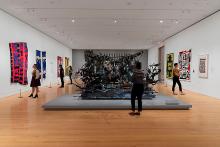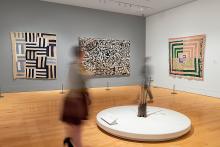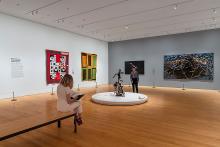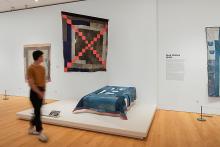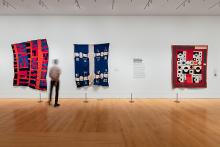The Philadelphia Museum of Art presents Souls Grown Deep: Artists of the African American South, an exhibition including paintings, sculptures, and quilts that celebrates the recent acquisition of 24 works from the Souls Grown Deep Foundation. Among them are outstanding examples of large-scale sculptures and reliefs by Thornton Dial, assemblages by Lonnie Holley, Ronald Lockett, Hawkins Bolden, and Bessie Harvey, and an impressive selection of multi-colored quilts made by several generations of women from Gee’s Bend, Alabama, and the nearby towns of Rehoboth and Alberta. Many of these pieces were composed of found and salvaged materials and are deeply rooted in personal history of their makers. This exhibition is presented in conjunction with The Art of Collage and Assemblage, a related exhibition of collages and assemblages from the museum’s broad holdings of American and European modern and contemporary art.
Timothy Rub, The George D. Widener Director and CEO of the Philadelphia Museum of Art, said: “We are proud of this important acquisition from the collection of the Souls Grown Deep Foundation, for it enables us to present a much richer account of the development of contemporary art. We have a long history of acquiring and exhibiting works by artists who have practiced outside of the mainstream. With this acquisition, we are delighted that we can now more broadly represent this distinctive aspect of American art which will enable us to share a more comprehensive account of modern and contemporary art in this country.”
While their subjects vary, the individual works featured in Souls Grown Deep are rooted in artistic traditions of the southeastern region of the U.S. and bound up with the personal histories of the artists who made them. Many of these works represent responses to issues such as poverty, oppression, violence, marginalization and racial conflict. The quilts span the period from the 1920s to the early 2000s, while the paintings and sculptures date from 1985 to 2004.
Among the most important works in this acquisition are three by the late Thornton Dial, who lived in Bessemer, Alabama. In the monumentally-scaled The Last Day of Martin Luther King, 1992, the image of a tiger—the artist’s frequent symbol of the struggle for justice endured by African Americans—represents Dr. King. Even grander in scale is High and Wide (Carrying the Rats to the Man), 2002, a scene of a slave ship formed in high relief out of metal, goat hides, barbed wire, and other materials gathered by the artist. In his The Old Water, 2004, Dial depicts birds flocking to a river and doubles as a critique of equal opportunity and government accountability in the U.S.
The exhibition contains two works by Dial’s friend, Lonnie Holley, also from Birmingham. A musician and poet, Holley uses found objects in such pieces as Protecting Myself the Best I can (Weapons by the Door), 1994, an assemblage consisting of a golf club, baseball bats, and a metal pipe. The artist collected these materials from a neighbor who had kept them by her door to protect herself from potential intruders, giving, them new meaning as a monument to the resistance to violence demonstrated by his neighbor and other African American women.
Two works by Dial’s cousin, Ronald Lockett, also from Bessemer, share the theme of racism manifested as violent public spectacle. Smoke-Filled Sky (You can Burn a Man’s House but Not His Dreams), 1990, depicts a house set on fire by the Ku Klux Klan. Lockett made several works about white supremacist violence against black communities. In Timothy, 1995, the artist incorporates metal, tin, wire, paint, and nails on wood to create a grid-like pattern that resembles a quilt. He made this work in response to the attack on a government building that occurred in Oklahoma City earlier that year, naming it after the domestic terrorist.
Represented by one work each are Tennessee artists Hawkins Bolden and Bessie Harvey. Bolden, who was visually impaired, constructed Untitled 1985, out of material collected around his Memphis neighborhood: a headboard, wire fencing, and upholstery. In Jezebel, 1987, Harvey combines tree roots with shells, glitter, beads, and other adornments to depict the biblical queen. The artist believed that by finding human features in twisted roots she was revealing the beauty of God’s creation.
The fifteen quilts in the exhibition show how artists from in and around Gee’s Bend—a relatively isolated community on the Alabama River just south of Selma—transformed well-worn materials into works of art. The women of this locale recycled clothing and goods of various fabrics including plain weave cotton, denim, corduroy, and sateen to create vibrant and colorful quilts that would not only serve a utilitarian purpose but also provided a creative communal activity. Quilts by Martha Jane Pettway, Annie E. Pettway, and Henrietta Pettway from the 1920s and 1930s are among the earliest examples. The three women were distantly related through marriage: their shared name reflects the history of Gee’s Bend as the place of the former Pettway plantation, which profited from enslaved labor. Works by Delia Bennet, Nellie Mae Abrams, and Louisiana Bendolph show different takes on the “housetop” motif, though they were made in the 1950s, 1970s, and 2000s, respectively. Louisiana’s mother-in-law, Mary Lee Bendolph, is represented by two dynamic quilts from the early 2000s, including one inspired by etchings that she made during a printmaking residency in Berkeley, California.
The exhibition also spotlights the textiles of the nearby communities Rehoboth and Alberta, illuminating the quilting legacies and master quilters unique to these locales. In Rehoboth, homes are spread out along a straight and narrow road, and quilts by residents Sue Willie Seltzer and Irene Williams feature strong vertical bands with perpendicular branches that recall the geography of the town itself. Rehoboth was also the site of the Freedom Quilting Bee, a cooperative founded in 1966 during the Civil Rights Movement, which empowered women financially through quilt auctions and commercial contracts with department stores like Sears and Bloomingdale’s.
John Vick, Collections Project Manager, who organized the exhibition with Souls Grown Deep Foundation Intern Akili Davis, said: “These works enable us to tell a fuller story about American art. They engage with the past, be it with local traditions or events of national significance, and they share an approach to artmaking that values recycling and reconfiguring the stuff of everyday life. They bring us into the present by advancing the conversation about who is called an artist and who is represented in art museums.”
